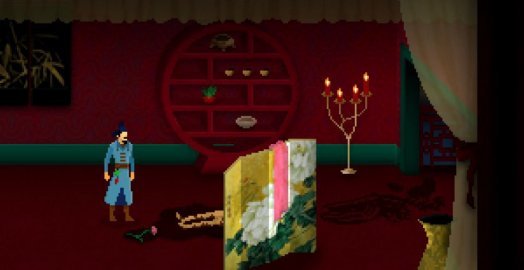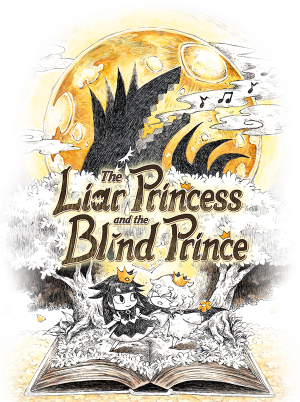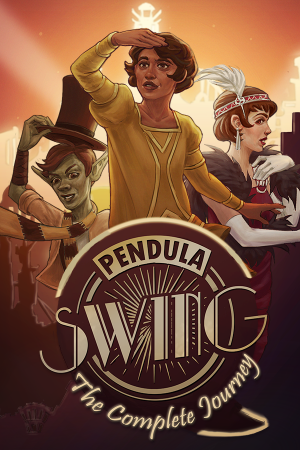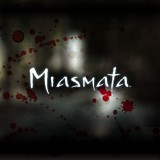Review for Detective Di: The Silk Rose Murders

Great Britain may have had Sherlock Holmes, and Belgium might have been home to Hercule Poirot, but China too had its own master detective. Di Renjie, the titular character of Nupixo Games’ Detective Di: The Silk Rose Murders, is every bit the brilliant investigator as his European counterparts, and a far sight more politically savvy. In this colourful and enthralling point-and-click adventure set in the seventh century, Di chases a serial killer in the midst of political unrest besieging the nation. That may sound dark, but it’s a lot of fun too!
Although certain characters and events in Detective Di are based on real historical subjects, the adventure itself is a work of fiction. Di Renjie – the real Di Renjie – served as an official in various postings throughout his career. He was already established by the time the Zhou Dynasty was created by the empress dowager Wu Zetian when she ascended to power. In Detective Di, the fictionalized account is a little different, presenting Di as a young investigator assigned to his first case less than a year before Wu (another key character in the narrative) takes the reins of command.
Di’s initial assignment in the small coastal district of Penglai serves as the game’s prologue. He has been summoned to a remote estate to investigate the murder of a Korean ambassador who was there to negotiate an important border treaty with the Chinese representative. With the death of the ambassador, a political crisis now looms unless Di can get to the bottom of the mystery. This section introduces the key gameplay elements, most of which will be familiar to players of classic point-and-click adventures.
Having completed the prologue with Di suitably impressing the higher-ups, events move forward ten months. The old emperor has died and his consort, Wu Zetian, has proclaimed herself the first empress dowager of China. Under this new rule, Di has been reassigned as the magistrate of law forces in the capital city of Chang’an. In short order he is summoned before Wu, who personally tasks him with looking into the grisly death of a young woman, Xu Linfei, who was strangled and then had her heart cut out. Di’s predecessor was less than competent and pinned the murder of Linfei on her father. However, Wu doesn’t believe the accusation and fears that it may be politically motivated to try to topple her from power. As you begin investigating, you’ll quickly find more bodies than you know what to do with, as Linfei turns out to be only the first victim of a serial killer who is intentionally leaving taunting notes and delicate roses at each crime scene, daring Di to catch up.
From the very beginning, Detective Di hooked me with its interesting characters and storytelling. Di himself is very serious about his job and seeing justice done, even when those of higher authority may wish he wasn’t. In contrast, I really enjoyed the quarreling brothers working at the library and the soup lady with her fixation on cats, as they brought a welcome lightness to what could easily have been a grim tale. The intrigue is skillfully doled out as well. With each murder I felt like I was getting closer to the criminal only for him (or her) to slip away again at the last moment. And while the game is a work of fiction, there are enough real historical elements woven into its fabric to make it particularly appealing. Such tidbits cover the different written languages used in China, political machinations both before and after the emperor’s death, and the secret police that the empress dowager may (or may not) have employed.
The retro-styled visuals also caught my eye in a positive way. Settings have a clean, pleasingly minimalistic style. Rich colours are used throughout so that even ordinary locations like the rain-dampened front yard of a simple home or a street of market vendors feel like unique places of interest. Besides such basic settings, the game also visits other varied locales like the ornate halls of the palace, a reflecting pool at a military man’s home, a pleasure barge, and an ancient tomb, among many others. These backdrops depict a rarely-explored culture and era, and the Eastern influences really help to make the experience stand out. Most of the areas feature some manner of parallax scrolling, which adds depth and makes the scenes even more expansive and impressive. Some even incorporate zooming in and out, which lends a nice cinematic flair.
The cast of characters fits well into these environs with a similarly minimalist look. This is not to be confused with a lack of detail, as there are plenty of those on display. Di Renjie’s asymmetric sprite is a good example, as whether he’s facing left or right it’s not simply the same sprite set flipped but rather distinct renderings of him looking each direction. It’s a subtle detail but one that I greatly appreciated. Other nice artistic touches include shadows underneath each character, and the kicking up of water when Di finds himself in a chamber that’s flooding.
Despite the gruesome nature of the crimes being investigated, Detective Di wisely doesn’t focus visually on gore. Bodies, when discovered, are usually covered up by some element of the background, such as a dressing screen or a railing. There are some blood-spattered pixels here and there but done in a tastefully understated way. Well, as tasteful as a crime scene where a victim’s heart is cut out and stolen can be.
The game's music can be both inconspicuous and bombastic. In some places, typically outdoors, the music drops out entirely and allows ambient sounds like the chirping of crickets to come through. Interiors, on the other hand, almost always have suitable music looping in the background. There’s a certain officiousness to the tune playing in the justice department, which contrasts nicely with the vaguely unsettling theme that plays when searching the murderer’s home. Each track has an appropriately Asian flavor, and I found they always enhanced their respective scenes and never became distracting. Sound effects are sparingly used but when employed serve to heighten the impact of corresponding events. The drawing of a sword or the satisfying click of an intricate lock disengaging are very rewarding in context.
Detective Di doesn’t feature voice-overs so all the dialog is presented as text. It’s quite well written with a good variety of speech patterns based on differences in formality, verboseness, and tone. I only came across a handful of typos in my seven-hour playthrough, and none was egregious enough to pull me out of the engrossing storytelling experience. There are a couple lines that struck me as overly modern turns of phrase for China circa AD 684, but these too are easily overlooked.
While the visuals and audio are somewhat limited, the gameplay is not, offering a good number of things to do. Crime scenes have to be investigated, suspects need to be interviewed via dialog tree conversations, items must be collected and various puzzles require cracking. These are dealt with in straightforward point-and-click fashion. Hovering the mouse over an important hotspot causes the pointer to highlight and a text description to appear. Clicking then typically presents two options: look and interact (or talk). Acquired items can be selected from a concealed inventory at the top of the screen and used in the environment.
In addition to the typical adventure game challenges, Detective Di has a nice assortment of logic puzzles as well. Whether it’s figuring out the particular arrangement of playing pieces on a Go board, solving actual riddles, finding a hidden message in a letter, or even solving a math-based combination lock, there’s plenty to keep you busy here.
Di also has a deduction board, which is quickly accessible through an on-screen button. As key evidence is found or conclusions are drawn during the course of normal gameplay, text items are added to the deduction board. The board itself is not interactive, serving instead as something of an information repository where critical elements of the current case are recorded. Several of these deduction boards are featured throughout the story, with each consisting of five or six crucial points that must be discovered.
Once all the necessary elements have been found, Di will then walk through a reenactment of the crime. During these stylish sequences, the crime scene is shown in black and white, with the important characters displayed in colour and Di standing to one side. The detective describes the scenario in three parts, with three dialog options presented between each part. It’s from these options that players must choose what actually happened based on the evidence collected and deductions made. For example, during the prologue Di has to reveal the murder weapon used on the Korean ambassador. In the reenactment, the actual weapon will be presented among the three choices along with two incorrect options.
It behooves players to pay attention to what is discovered and recorded on the deduction board during each case in order to successfully pick the correct answer. If a wrong answer is chosen, however, that step of the reenactment will be replayed so a different answer can be selected. This continues through all three stages until all correct answers have been identified, so there is no risk of failure, though of course it is more satisfying if you earn your success through keen observation rather than guesswork.
During my investigation I did encounter a couple occasions of pixel hunting, and with no hotspot highlighter certain items may need to be ferreted out by carefully sweeping the scene with the mouse. There is also one puzzle involving a woman with a dodgy memory who had taken a book on languages from the library but can’t be shown a document written in a different language until adequately reminded that she had in fact taken the book out. It seemed a little logically backwards to me, but it was the only such instance in the entire game. All told, these blemishes are just minor wrinkles in an otherwise flawless tapestry.
Eschewing the modern trend of only a single autosave, here you are allowed any number of manual saves. As far as I can tell it’s not really necessary to do so, but it’s still a very nice touch to be able to record your progress at any point. I only wish the save games could be renamed. Instead they’re given generic “Save 1”, “Save 2” type of labels and have no accompanying picture with them, making them a little difficult to remember where they occurred. However, the fact that the game has free saving at all is fantastic!
This may be their first game, but Nupixo has clearly paid attention to what makes for a good adventure, as Detective Di: The Silk Rose Murders gets almost everything right. It is an involving mystery that spans a great deal of interesting and beautiful locations. Yes, it’s modest in its production values, but it’s set in a time and place that few games have ever ventured before, and is even sewn through with little bits of real history for added authenticity. The characters Di meets have differing personalities and backstories, and the pursuit of the killer genuinely feels like the culprit is always one step ahead of you, daring you to finally put an end to the chase. The puzzle variety is just as good, keeping the investigative gameplay compelling throughout. It doesn’t take a master detective – or magistrate, as the case may be – to deduce that this is a great game with wide appeal for any adventure fan.































